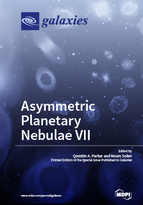Asymmetric Planetary Nebulae VII
A special issue of Galaxies (ISSN 2075-4434).
Deadline for manuscript submissions: closed (30 June 2018) | Viewed by 78454
Special Issue Editors
Interests: late stage stellar evolution; wide field surveys; astronomical instrumentation
Special Issues, Collections and Topics in MDPI journals
Interests: theory; late stage stellar evolution
Special Issues, Collections and Topics in MDPI journals
Special Issue Information
Dear Colleagues,
Thank you all for agreeing to publish your APNVII conference presentations in the form of a paper submitted to the special peer reviewed conference proceedings kindly offered to us by the MDPI Galaxies journal. Below is a brief summary of the focus, scope and purpose of this special issue for your information. We look forward to receiving your submissions and the production of this special issue.
a. Focus: This Special Issue’s focus will be broadly based around the current broad and major themes and questions regarding late-stage stellar evolution, and especially planetary nebulae, via the invited and submitted talks
b. Scope: The scope of the meeting and, thus, the contents of this Special Issue include:
- Shaping Mechanisms—role of binarity, magnetic fields and other factors
- What can we learn from the major increase in known PNe?
- How are post-AGB, pre-PNe and PNe phase shapes related?
- What role do the properties of the central stars play?
- What can we learn from jets and accretion disks in related/unrelated objects?
- What do advances in evolutionary models and timescales tell us?
- How do we maximally extract science from the available/planned facilities?
- What are the most important current issues to resolve?
c. Purpose of the Special Issue:
- This Special Issue will bring together the contents of the meeting and capture the status of the field at this time, in some real sense, and can become an important historical record
- Special refereed conference proceedings will be well received and used as decent reference materials by participants and others, and will lead to increased cites in the field, and for the authors
- The included reviews can be very useful
- A Special Issue raises the profile of our community and the science we do
The Special Issue will form an important historical record of a major international conference and will include up to the minute cutting-edge materials that would not normally appear in the literature until 12–18 months later, when full refereed papers are eventually produced. The community will get a “heads-up” on important advances and thinking in a more timely manner.
Prof. Quentin A. Parker
Prof. Noam Soker
Guest Editors
Manuscript Submission Information
Manuscripts should be submitted online at www.mdpi.com by registering and logging in to this website. Once you are registered, click here to go to the submission form. Manuscripts can be submitted until the deadline. All submissions that pass pre-check are peer-reviewed. Accepted papers will be published continuously in the journal (as soon as accepted) and will be listed together on the special issue website. Research articles, review articles as well as short communications are invited. For planned papers, a title and short abstract (about 100 words) can be sent to the Editorial Office for announcement on this website.
Submitted manuscripts should not have been published previously, nor be under consideration for publication elsewhere (except conference proceedings papers). All manuscripts are thoroughly refereed through a single-blind peer-review process. A guide for authors and other relevant information for submission of manuscripts is available on the Instructions for Authors page. Galaxies is an international peer-reviewed open access semimonthly journal published by MDPI.
Please visit the Instructions for Authors page before submitting a manuscript. The Article Processing Charge (APC) for publication in this open access journal is 1400 CHF (Swiss Francs). Submitted papers should be well formatted and use good English. Authors may use MDPI's English editing service prior to publication or during author revisions.
Keywords
- late stage stellar evolution
- planetary nebulae
- binarity
- magnetic fields
- multi-wavelength photometry
- stellar evolution
- theory and observation







